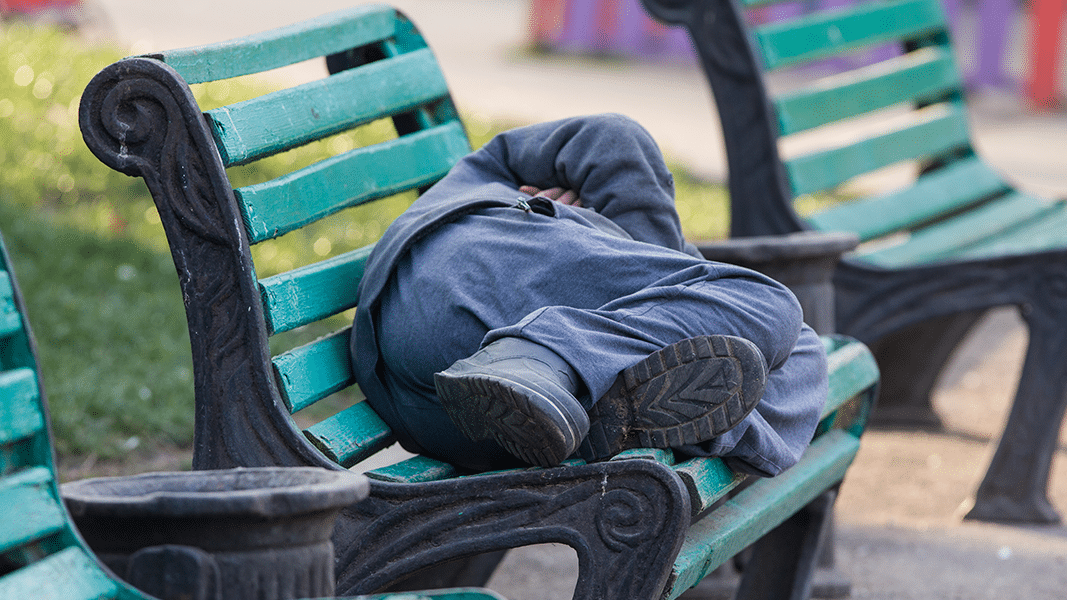“Hello, Miss Amy!” a woman calls out, pushing a shopping cart stuffed with her life’s possessions.
I’m in the Tenderloin district of San Francisco, masked up and walking with homelessness activist Amy Farah Weiss. Everywhere we go, people know “Miss Amy” by name.
We pass ramshackle apartment buildings, dingy coffee shops, and brightly lit Asian eateries. Getting around is tricky: front stoops, sidewalks and gutters are occupied by a chaotic community of people, dogs, and bicycles. Piles of belongings are scattered everywhere.
The scene is post-apocalyptic, but Weiss is unfazed as we approach a vacant lot surrounded by a chain link fence and filled with tents. Inside we make the rounds, checking in with people while Weiss passes out packets of CBD-rich hemp products – prerolls, tinctures, and other items donated by cannabis companies and hemp growers.
A discussion ensues about the properties of cannabis: what it is, how to use it, the issues people are struggling with and ways that medical cannabis might help. Several folks join the conversation, sharing their thoughts about the kind bud and its derivatives. Weiss takes notes on any progress or feedback.
Hybrid Activism
Berkeley-born and Bay Area-bred, Weiss learned about the therapeutic applications of cannabis while counseling patients at the Apothecarium, a San Francisco medical marijuana dispensary. Fascinated by the science of cannabis therapeutics, she also worked as an education consultant to Dr. Hanya Barth, a respected Bay Area clinician. This experience informs her passion as a homelessness activist.
Weiss’ blend of Peter Pan coif, non-binary gender preference, and playful yet no-nonsense Mama Bear demeanor defies simple characterization, as does her hybrid background in environmental and native studies, feminist theory, and organizational development. Plus several years of grassroots advocacy in a range of direct outreach environments – a psychiatric hospital, a women’s shelter, at-risk youth programs, and a sustainability village.
Weiss founded the non-profit organization Saint Francis Homelessness Challenge (SFHC) in 2015, after placing third in a run for Mayor on a platform that included the implementation of transitional off-grid villages to address street homelessness. SFHC’s stated mission is to create “places of belonging that focus on shared agreements, essential needs, and local stewardship” in an effort to build a bridge from the streets to a stable, healthier, more productive life.
“It’s about time to connect people who need places to belong, with places that need stewardship,” says Weiss.
While San Francisco has struggled for years to address its homeless crisis, the COVID-19 pandemic has forced the issue. When the city issued social distancing orders in mid-March, homeless shelters had to close in order to comply. The result was a surge of unsheltered, very-close-together bodies on the streets, an increase of more than 250% in the downtown Tenderloin district alone.
People who’d paid little attention to the homeless crisis now suddenly couldn’t avoid it. Residents and business owners in the Tenderloin sued the city, alleging that impassible sidewalks, free-flowing drugs, and overcrowded, unsanitary conditions had created a neighborhood health risk. San Francisco settled with the plaintiffs and agreed to remove 300 tents – and those living in them.
Sweeps to Nowhere
“I’ve been to this rodeo before,” Weiss responds when asked about the recent lawsuit and the city’s tent removal plan. “San Francisco spends tens of millions of dollars each year on ‘sweeps to nowhere’ and people often just end up on another block. It’s a straightforward math problem, really. Unless we have a sufficient amount of safe and dignified exits from homelessness we are going to keep seeing people living on our streets.”
It’s pretty obvious to Weiss whom the shelter-in-place orders don’t protect. While the virus continues its pernicious spread in the Bay Area — one of the wealthiest regions in the country — its most vulnerable residents are left to fend for themselves.
Unsheltered individuals are at extremely high risk of contracting the virus, given that they lack access to proper sanitation, protective masks, dependable healthcare, and the ability to adhere to shelter-in-place and social distancing guidelines. And the majority have underlying health conditions.
A recent University of Pennsylvania report estimates that unsheltered homeless individuals are twice as likely to be hospitalized, two to four times as likely to require critical care, and two to three times as likely to die from COVID-19 than the general population. To decrease these odds, the report suggests that shelter for 400,000 individuals throughout the country must be provided immediately.
The pandemic has dramatized the need for a new and different approach to fight street homelessness. Weiss has developed a plan that prioritizes industrial as well as medicinal hemp as core elements of a holistic, interdisciplinary strategy, one that draws upon the combined talents and skills of other social justice oriented and sustainability-minded collaborators.
“St. Francis said, ‘First do what’s necessary, then do what’s possible, and soon you will be doing the impossible,’” Weiss explains. “It’s how we work.”
An Invaluable Medicine
In addition to the stress of homelessness, many people living on the street suffer from PTSD and untreated mental illnesses, as well as pain disorders and other health issues. Weiss is convinced that rampant drug addiction in the Tenderloin is most certainly aggravated – if not caused – by the ongoing trauma that lack of shelter and other basic unmet needs perpetuate. “People on the streets often feel like they need to use certain drugs to stay alert to protect themselves, or to take a momentary pause from crisis and unhealed trauma,” says Weiss.
SFHC peer organizer Aljerone Green understands this firsthand. He found cannabis to be an invaluable medicine when making the transition from incarceration back into society. An elegant, gregarious man with a breathtaking smile and a voluptuous mane of dreadlocks, Green was raised by his grandparents in Santa Clara and says his lifelong challenges began in an unstable family environment. An unfortunate chance encounter in his early 20’s with an older white man led to a one-year prison sentence, despite Green’s claim of self-defense against a racially-charged physical attack.
Once released from prison, Green struggled to adjust and find work. He managed by using a “gig app” on his phone, jumping into whatever jobs he could — catering, event set-up, janitorial, food prep, warehouse work, moving and packing, etc. Somehow he also managed to find time to volunteer for social justice causes he believed in. Still, the constant stress of reintegration triggered a lot of anxiety. With support from Weiss and SFHC, he turned to cannabis for help.
“Cannabis helped me slow down,” Green explains. “It quelled my anxiety, cleared my mind of racing thoughts, and also improved my appetite, which is something I’ve always struggled with.”
According to the National Alliance to End Homelessness, persons of color are 30 times more likely to suffer homelessness than whites, a stark reality that Green believes is deeply rooted in the past. Years of systemic racism and its consequences — poverty, unemployment, a lack of access to education, decent healthcare and property ownership, as well as unequal treatment under the law — have resulted in deeply-embedded, generational trauma.
“By the time people hit the streets,” according to Green, “they’ve lost all hope. They don’t trust anyone. Regaining that trust and rebuilding hope takes support and time, but it’s possible.”
Green still uses medicinal cannabis daily, including THC-rich and CBD-rich varietals, while maintaining a busy, productive schedule. With help from cannabis, he weaned himself off numerous prescription meds for sleep, pain, anxiety and depression, a success story he loves to share with the folks he works with.
Harm Reduction
“Cannabis can be an invaluable harm reduction tool,” says Green, who espouses a say-yes-to-weed-and-no-to-hard-drugs agenda. “SFHC has taken the time to educate people about all kinds of drugs and their effects, including cannabis with its array of cannabinoids and how they can help.”
Weiss and her team recently interviewed 100 homeless individuals in the Tenderloin to better understand what would help improve their situations. After their top concern — a safe, stable, private space to lay their heads and lock up their belongings — sixty-seven percent were also interested in trying medicinal cannabis to transition from harder drugs.
Research supports this idea. A 2017 study examining the use of cannabis as a substitute for opioid medication found that 97% of those sampled reported they were able to decrease their pain meds. And 81% found less opioids to be more effective at treating their pain when combined with cannabis. Although it’s legal in the California, cannabis has yet to be included in state-licensed drug treatment programs.
“For cannabis to be effective, people need a reliable, consistent, affordable supply,” says Green. “On the streets, a sack of meth or a fifth of vodka is much cheaper than an eighth of an ounce of cannabis. When someone only has a few bucks in their pocket, they’re going to go the cheaper route. There’s no system in place to get them cannabis as an alternative. The idea is still too new.”
SFHC is pioneering this effort, while seeking support in the form of donated flower, tinctures, capsules, and other products from cannabis companies, hemp growers, dispensaries, and CBD brands. (Contact SFHC directly for more information on how to contribute.)
Weiss obviously understands that cannabis is not going to solve all the problems of homeless people, but it could be a stepping-stone away from dangerous drugs. And by calming and balancing the nervous system and buffering stress, it can ease some of the emotional and psychological burden that homeless individuals experience.
That, however, is not enough. “Safe, organized spaces, a sense of belonging, and shared agreements have to be part of the plan,” says Weiss.
Sustainable by Design
Paul Richardson, a U.K.-born architect and founder of the sustainable building group HavenEarth, has joined forces with Weiss to address the homelessness crisis.
After a globe-trotting career designing, building, and managing the construction of a variety of high-end modern buildings, Richardson experienced a reckoning of sorts in 2017 while trekking in the Amazonian jungle in Peru. Immersed in this intense natural environment, he realized the work he was doing was destructive, lacking in authenticity and meaning.
Richardson spent the next couple of years unlearning a lot of what he was taught in architecture school. He rejected the corporate model that typically makes use of toxic materials shipped from across the globe to create energy-inefficient structures with a high carbon footprint. Instead, he turned towards nature as a template for better building strategies.
Intent on creating houses and other structures that are healthy for the body and mind, as well as the environment, Richardson traveled to Turkey, Russia, Africa, Switzerland, Northern California and elsewhere to learn as much as he could about sustainable architecture and building techniques that rely on locally sourced materials.
The use of hemp as a construction material kept coming up in natural building circles Richardson participated in. At first, he questioned whether hemp was a viable option in terms of its environmental impact, price point, and feasibility. But working on a hemp house project in Switzerland with Hemp Eco System’s Jorge Hempel convinced him that this was the way to go. On every front, hemp satisfied the criteria as a versatile, green, and cost-effective material.
Built to Breathe
Hemp, or what is often referred to as industrial hemp (cannabis sativa strains bred for fiber rather than resin production), has been cultivated for thousands of years for a variety of practical uses. It is a bast fiber plant, meaning that its valuable flexible fiber is contained in the inner bark of the stem. This fiber must be separated from the woody core in a process called decorticating or retting before it can be used to make rope, textiles, and numerous other products. During processing, the inner core is broken into pieces called hurds or shives, which can be mixed with natural lime and other powdered minerals to make a lightweight yet surprisingly strong building material that is moisture-regulating and fire-resistant.
Known as “hempcrete,” this thick slurry is then added to a basic foundation, framing, and some structural form (often a type of mesh) to hold it into place. To “hemp a house” (Richardson likes to use the word “hemp” as a verb) is a community event that can include people of all ages and abilities, with everyone engaged in pouring and patting the hempcrete into place. Afterwards, the hemp-infused walls must dry and cure.
“A hemp building just feels good,” says Richardson. “It offers good insulation and yet it ‘breathes,’ allowing a fresh exchange of air.”
Most modern buildings enclose a toxic environment, he says, filled with off-gassed chemicals and distractions, endless gadgets and stale air. A hemp building is different. “It’s closer to the feeling we get when we are out in nature. It’s like bringing nature inside.”
“Hemp is a connecting plant,” he continues. “A high biomass plant [with] amazing and usable properties. We have the opportunity to use hemp to inspire young people, help them see the potential in working sustainably with nature, with agriculture, and feel good about it. Hemp can give them hope for the future, something the next generation desperately needs.”
Hemp Sleeper Cabin
Not long after Richardson started building hemp structures, he learned of Amy Weiss’s idea for a mobile, modular hemp sleeper cabin that could be used as triage shelter and/or transitional housing for homeless people. It had to be affordable, durable, fire-resistant, and California code compliant. Weiss needed someone with the right skill set to design and build a prototype, and Richardson immediately jumped on board.
“The Hemp Sleeper Cabin project signifies something important,” says Richardson, who currently resides in New Mexico. “The way homelessness is addressed in this country is to look for cheap solutions, like ‘What can we get for nothing, so we don’t have to invest in the sector of society that we’d rather forget about.’”
Richardson’s old-is-new architectural savvy and his formidable building skills were a perfect match for Weiss’ boots-on-the-ground expertise. Today a nearly finished, 70-square-foot, arch-shaped hemp cabin prototype sits on a trailer next to Richardson’s Santa Fe home. It includes a bed, storage, window/second exit, solar-powered lighting and charging, and a locking door. Designed with strength, thrift, and versatility in mind, it’s meant to be easily constructed and customizable.
The first cabin is slated to be finished in August – with many more to follow. As mobile units, the hemp sleeper cabins will have the flexibility to create transitional or semi-permanent villages, offering a respite from the frenetic, stress-laden life on city streets and sidewalks.
“It’s a simple, peaceful design, symbolic of a transition from a crisis situation to a healthier state of being,” says Richardson, “a process that not just the homeless are going through. We’re all in that process right now on the planet, in one form or another.” One way to help that process along, he suggests, is to “re-indigenize” our modern life patterns, incorporating old knowledge into new systems.
Building Alliances
Both Weiss and Richardson believe that the design and construction of sustainable hemp dwellings provide a chance to expand on what sustainable agriculture has been doing with food production, with its farm-to-table ethos of supporting local producers and regenerative farming practices. The sleeper cabin initiative will form partnerships to develop supply chains for various “green” building materials – from powdered lime to basalt, a natural mineral used as ultra-strong, non-corroding, fireproof structural material.
Weiss and Richardson have formed an alliance with Fibershed, a non-profit that promotes the use of sustainable fiber for textiles, housing, and other purposes by helping to connect fiber producers, processors, designers, manufacturers, retailers, and consumers. Fibershed contributed $15,000 to develop the hemp cabin prototype, and it’s coordinating a supply of locally raised natural wool to use as insulation in the cabin’s roofing.
“Wool is a great complement to the hemp materials,” says Heather Podoll, Advocacy Coordinator of Fibershed. “It’s breathable, helping to filter and improve indoor air quality, and is also fire-resistant, with temperature and moisture-regulating qualities.” The fire-resistant properties of wool and hempcrete are essential, given the devastating annual firestorms in California.
What’s more, according to Podoll, at some future time when the buildings are no longer useful, their natural materials can be composted, serving to nurture the soil. Or the materials themselves can be reused and perhaps repurposed to produce more natural building material.
Podoll believes that the thoughtful sourcing of materials for the hemp sleeper cabin project “supports restorative regional land management, regional economic development, and a healthy, living environment for the inhabitants of the shelters.”
Weiss and Richardson couldn’t agree more. Strengthening local communities is a key aspect of their collaborative plan. Further down the line, they envision incorporating regenerative hemp cultivation into the project. And regeneratively-grown CBD-rich cannabis, as well. Like the properties of the plant, the possibilities are many.
“We’re going back to the future,” says Weiss. “Hemp is our future. It’s really exciting to me. It’s about time to feel excited.”
An Economics of Well-Being
As we are leaving the Tenderloin, Weiss tells me that she’s inspired by New Zealand Prime Minister Jacinda Ardern’s ideas about an “economics of wellbeing” and how this philosophy has been integrated into that nation’s government. Weiss has adopted some of these ideas in an effort to address the homelessness crisis.
“How do we identify our values and use them to create a metrics to measure what matters?” she asks. “Can we use ‘belonging’ and ‘wellness of our bodies and the land’ and ‘meaning’ and ‘the ability to contribute’ as part of the metric when we’re trying to solve street homelessness, rather than tallying the number of tents the City has removed and pointing to that as some kind of success?”
Since I last spoke with Weiss, Aljerone Green told me about a positive development in the neighborhood where he works as a peer organizer and counsellor. Several weeks after the corona-freak-out tent-sweep in the Tenderloin, city officials began to provide temporary housing in hotels and “safe sleeping villages” for those displaced from shelters because of the pandemic. This is a huge step, according to Green. It’s something that the SFHC has been advocating — the importance of safe, organized spaces in the transition away from street homelessness.
“Now that some people have shelter,” says Green, “it’s life-changing. When people have their basic needs, they can begin to heal and regain a sense of hope. It’s the perfect time to get them on a recovery program that includes medicinal cannabis.”
SFHC is seeking tax-deductible donations, partnerships, sponsorships, and in-kind contributions (hemp fiber, minerals, trailers, solar energy kits, etc) to build and distribute 10 Hemp Sleeper Cabins to municipalities in California and New Mexico once their prototype is completed in August 2020. Inquire at info@saintfrancischallenge.org and/or donate directly.
Melinda Misuraca is a Project CBD contributing writer with a past life as an old-school cannabis farmer specializing in CBD-rich cultivars. © Copyright, Project CBD. May not be reprinted without permission.
Recommended Readings
Cannabis Better than Big Pharma for PTSD
A survey of 300 patients suggests that cannabis is better than Big Pharma for common PTSD symptoms.
Medical Cannabis Can Help America’s Opiate Crisis
A doctor discusses a neglected treatment option for opioid addiction: medical marijuana.
Hemp Farming While Black
Can rural African Americans overcome centuries of oppression to forge a new agrarianism with cannabis?














